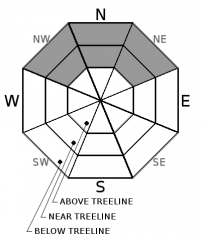| Sunday | Sunday Night | Monday | |
|---|---|---|---|
| Weather: | Mostly cloudy with a slight chance of snow showers in the afternoon | Cloudy with a chance of snow showers | Mostly cloudy with a chance of snow showers throughout the day |
| Temperatures: | 30 to 35 deg. F. | 22 to 27 deg. F. | 34 to 39 deg. F. |
| Mid Slope Winds: | Southwest | Southwest | Southwest |
| Wind Speed: | Light in the morning increasing to 10 to 15 mph with gusts to 35 mph in the afternoon | 15 to 20 mph with gusts to 45 mph | 15 to 20 mph with gusts to 45 mph |
| Expected snowfall: | 0 | up to 1 | up to 1 |
| Sunday | Sunday Night | Monday | |
|---|---|---|---|
| Weather: | Mostly cloudy with a slight chance of snow showers in the afternoon | Cloudy with a chance of snow showers | Mostly cloudy with a chance of snow showers throughout the day |
| Temperatures: | 26 to 31 deg. F. | 19 to 24 deg. F. | 29 to 34 deg. F. |
| Ridge Top Winds: | West and southwest | Southwest | Southwest |
| Wind Speed: | 15 to 25 mph with gusts to 30 mph increasing to 40 mph in the afternoon | 20 to 35 mph with gusts to 55 mph increasing to 65 mph after midnight | 25 to 35 mph with gusts to 70 mph decreasing to 15 to 25 mph with gusts to 50 mph in the afternoon |
| Expected snowfall: | 0 | up to 1 | up to 1 |

























